III.
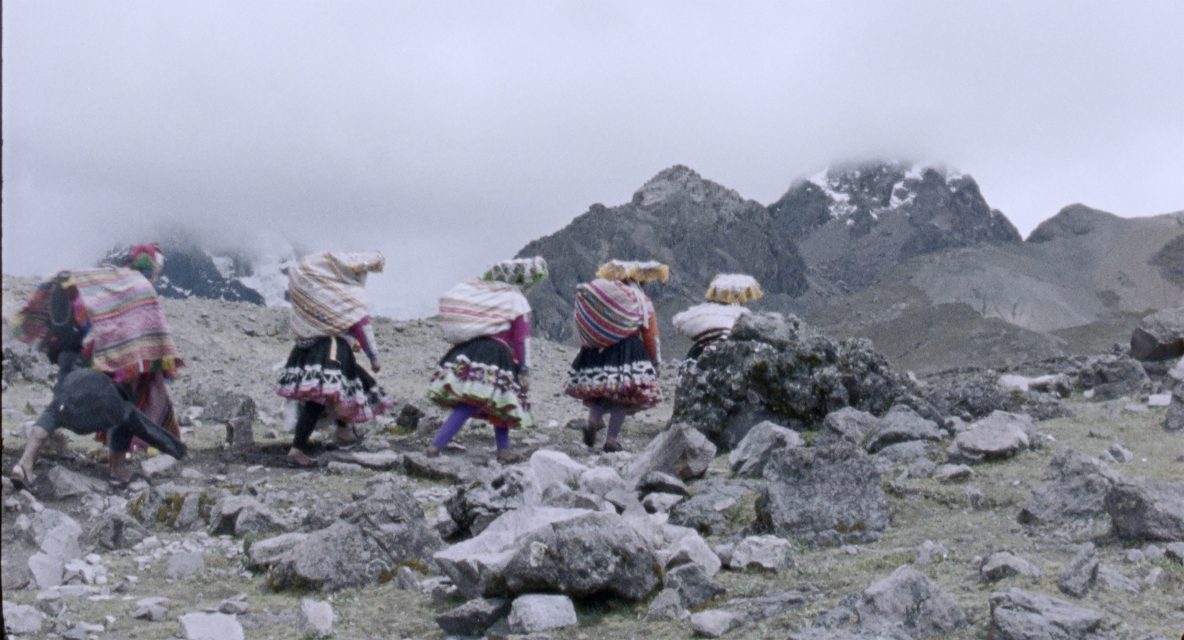
Aggregate States of Matters (2019), 35mm film, color, optical sound, 18 min. Film still. All images: Unless otherwise noted, © Rosa Barba.
ART iT: Talking about the landscape as an archive reminds me of Jorge Luis Borges’s fragmentary short fiction “On Exactitude in Science,” which is about an empire that creates a one-to-one map of its territory only for the map to fall apart from neglect. I think of the archive as a gesture toward a one-to-one map, in that it ascribes a fundamentally equal significance to everything it contains. This one-to-one sensibility also relates to documentary practices. When do you have enough material for capturing the reality of an event? When do you shut off the camera? The only way to do it properly is to leave the camera running indefinitely.
RB: Of course, when you work with analog film there are limitations that force you into making decisions. I found out there is a sort of conversation that happens with the camera when you work with people on analog film. It decides when to turn itself off or on. It’s like a gentle dance or performance that arises out of the relations between the camera and the subjects and the filmmaker. The decisions happen without defined rules. The landscape is of course different from people, but I do my best to film it in the same way. I try to establish a gentle agreement with the landscape as to where I film, how I approach it, and what to show or not show. A lot of the decision making already happens through the camerawork, even before I start editing the footage. (1)
ART iT: Could we look at White Museum as a gesture toward the long take—the indefinite, if not the infinite?
RB: It’s true. It’s like an unedited shot. But I should add that things that I don’t have any control over, such as the time of day or the weather, also decide how it is seen. The work is much more visible when there’s fog than on a clear night. Usually if you’re inside the building all you hear is the sound of the projector, and then you might see the light of the lens. But the piece itself grows into the night and takes different shapes depending on the weather. For example, the version I did in 2018 at the Remai Modern Museum in Saskatoon, Canada, was projected on to the South Saskatchewan River. With the extreme weather changes there, sometimes the piece was nearly invisible, while at other times it was like a clear screen.
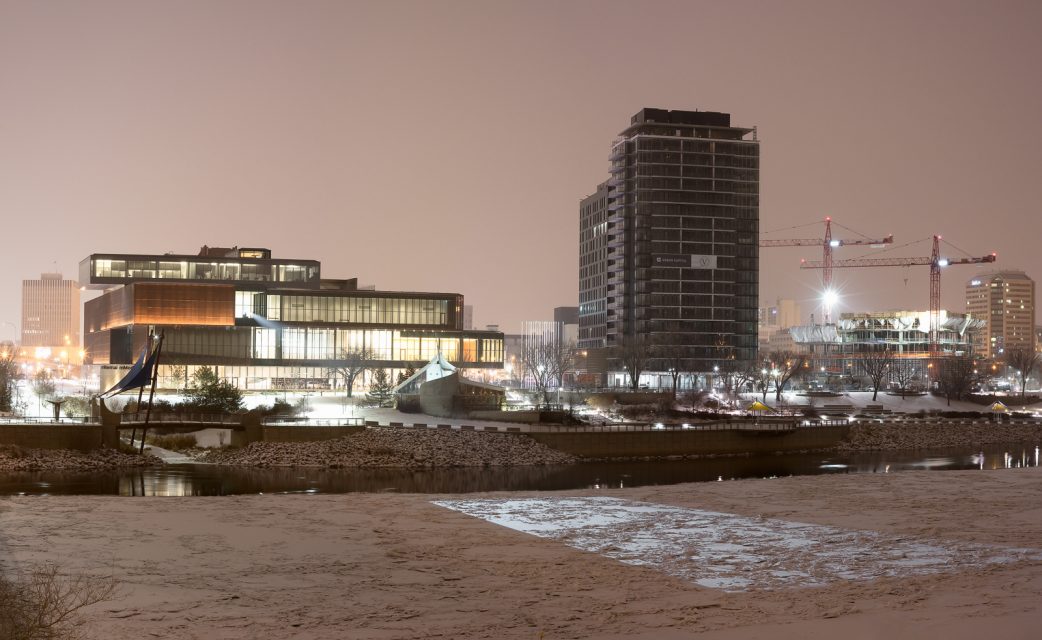
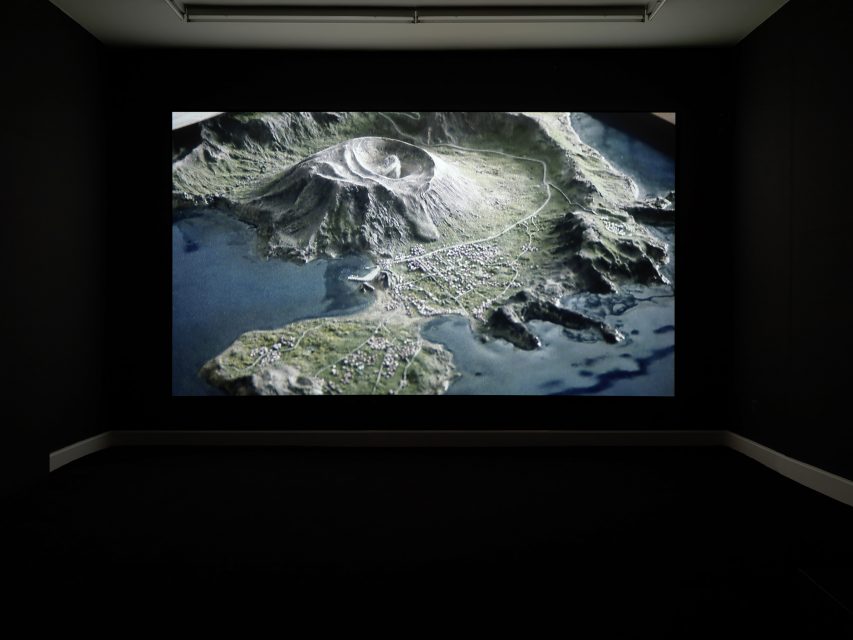
Above: White Museum (South Saskatchewan River) (2010/18), 70mm white film, projector. Installation view at Remai Modern, Saskatoon, 2018. Photo Blaine Campbell. Below: The Empirical Effect (2010), 16mm film transferred to video, color, sound, 22 min. Installation view at Kunstverein Braunschweig, 2011.
ART iT: There is also the film you made on Mount Vesuvius, The Empirical Effect (2010), which touches upon how life goes on next to the volcano despite the threat that everything could be destroyed by an eruption at any time. So the landscape is a document that also erases itself.
RB: (2) I started thinking about the Vesuvius project many years before I actually made the piece, because I was fascinated by the idea of a high-density population of some 600,000 people living in the danger zone of a highly unpredictable volcano. The last eruption was in 1944. Many older people say that the volcano is dead now after being bombed by the Americans, so nothing will happen. Others are very scared, and use the animals they keep as living seismographs. When I started working with local volcanologists and having conversations with them, I heard about a plan to organize a mass evacuation drill to see whether it really is possible to evacuate 600,000 people from the area in a week. The authorities even prepared forms for residents to indicate their preferences for evacuating by boat or plane and so on.
I thought, my god, this evacuation week would be an incredible setting for a film, so I got in touch with the Ministry of the Interior in Rome and then applied for funding to make a film that would take place at the same time as the evacuation. But every time I started planning a shoot date they would say, Oh, it’s been cancelled, we’ll do it later. This went on and on, and I always had to tell the film fund, Sorry, I can’t shoot this year, the evacuation has been postponed.
Then one of the volcanologists gave me a call and said, Listen, this is never going to happen, it will just keep getting postponed. In any case, it’s impossible. The bridges are too low for even a firetruck to pass. So I realized that this was another fabrication for keeping people feeling secure.
Normal life is suspended in the area because of the unpredictability. For example, the mafia hide out near the volcano because it’s a kind of free zone since it’s so volatile. And there is a lot of illegal manufacturing with Chinese immigrants. There was a film about how the Chinese workers are not allowed to die there. They have to be transported away before they die, as if they never existed there in the first place.
On one hand the volcano is like a time bomb, and then on the other hand there are all these other hidden histories and times that are shifting around it as a subject. Once I started thinking about it this way, I knew that I wanted to create the evacuation myself. I asked a village that is mostly populated by mafia people if they would participate in an evacuation for the film.
ART iT: A mafia village?
RB: It’s not like the whole village are mafia, but there’s a famous story about a really brutal guy who was living there. Although he’s in prison now, people say he still has connections in the village. I thought this is the place that needs to be evacuated. In fact, many of the people I spoke with agreed to participate. For instance, a lot of people participated in the scene where the villagers open their windows to get some “fresh air.”
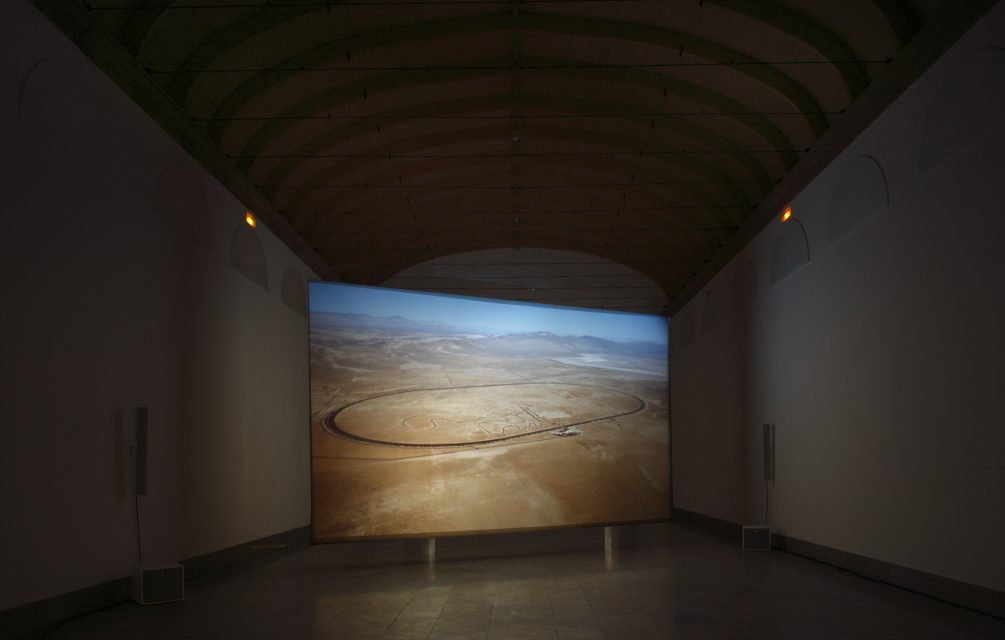
The Long Road (2010), 35mm film, color, optical sound, 6:14 min. Installation view at Centre international d’art et du paysage Ile de Vassivère, 2010.
ART iT: Let’s hold on to this idea of being close to death in both physical and temporal senses. People have compared what you do to the work of Robert Smithson—most obviously in the case of The Long Road and Smithson’s Spiral Jetty (1970), both of which feature aerial views of circular interventions into the landscape. What I find remarkable here is not so much the visual parallel between the works as it is the format of filming from the air. Smithson, of course, died in a plane crash, so your act of aerial filming, in its evocation of him, is also an act of being near death—and that in itself suggests a kind of form.
RB: Yes, I feel closer to the way Smithson produced and thought about his work than the actual works themselves. Of course The Long Road is a representation of what could be seen as a Land art piece, but that is quite different from what Smithson was actually doing. Although maybe Spiral Jetty now informs how we think about functional constructions in the landscape—whether tracks for testing cars or test sites for atomic bombs. Smithson opened up a certain mental space for understanding the world and the things we make in it. As with so many of the Land art works, he shows us that we can only ever contribute a small fragment to the larger understanding.
What I like about aerial photography is that it allows me to create suspended images. We lose the cues for comprehending how large something is or how close we are to it, so it offers another view on how to depict and perceive images. I feel a connection with ancient cultures who inscribed designs into the landscape that were meant to be seen from the air and could only be comprehended from an aerial view—which at the time would only have been possible for a god. There is a certain anarchy to this perspective that allows us to look freely.
ART iT: The bird’s- or god’s-eye view is actually anarchic?
RB: I don’t see it as a god’s-eye view per se, but in a way it is anarchic because there is no order. There is nothing like a ground that causes one thing to stick out more or establishes it as more important than something else. You see everything at the same time, so there is nothing telling you how to read the image. (3)
I | II | III
.
(1)
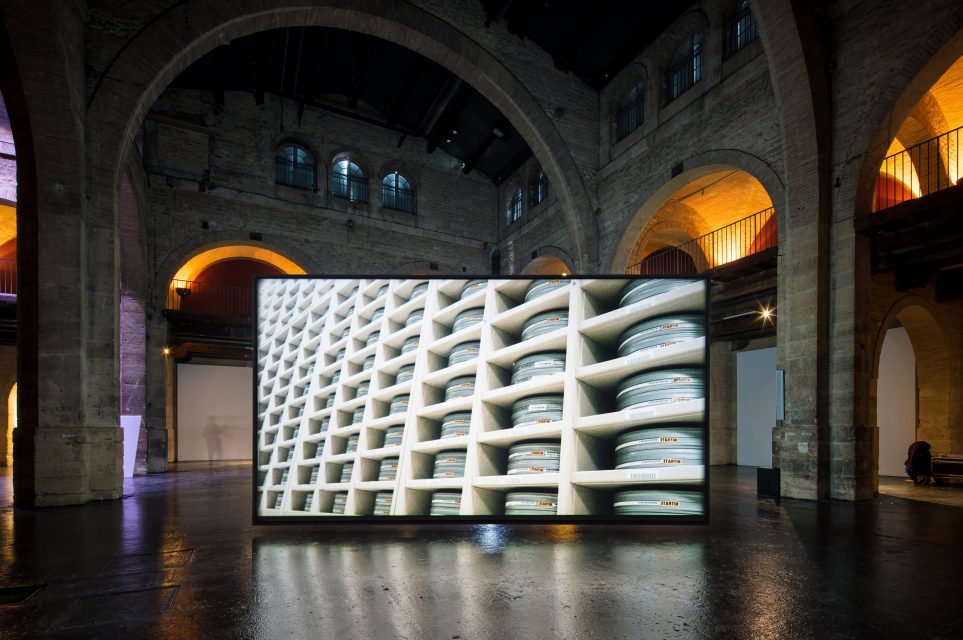
From Source to Poem (2016), 35mm film, color, optical sound, 12 min. Installation view at CAPC Bordeaux, 2016. Photo Arthur Pequin.
I introduce other possibilities into the text, or the people I include in my films introduce wishes or visions for a subject that is not real. These act as instruments to push the idea further. These wishes are anchored in real statements by people or from literature. For example, in From Source to Poem, the idea of the Library of Babel correlates to the Library of Congress. Jorge Luis Borges’s fiction “The Library of Babel” describes a library in which the books feature all the possible combinations of 25 orthographic symbols comprising 22 letters, the period, the comma and the space sign. According to the narrator, this amounts to everything that can be expressed in all languages: “the minute history of the future, the autobiographies of the archangels, . . . a version of each book in all languages, the interpolations of every book in all books.“
.
(2)
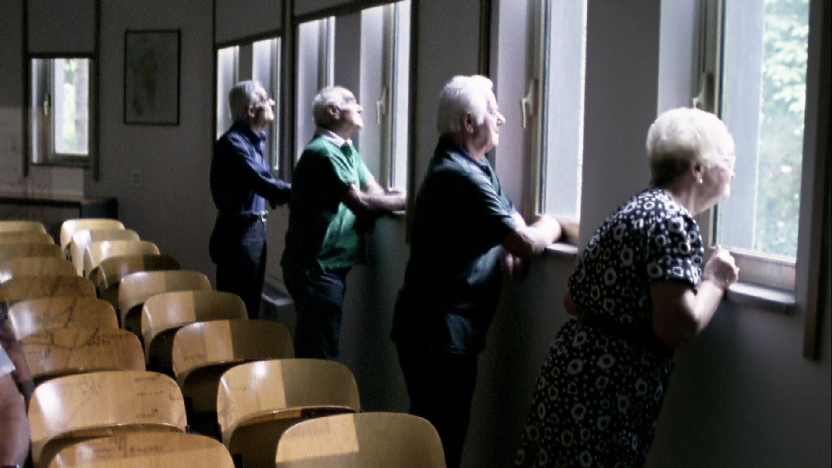
The Empirical Effect (2010), 16mm film transferred to video, color, sound, 22 min. Film still.
For me the volcano has always represented a central metaphor for the complex relationships between society and politics in Italy. At the foot of the sleeping monster the mafia runs its empire, filtering untold numbers of illegal Chinese migrants into a secretive parallel society. The migrant workers are visible only in their social impact. Meanwhile, all official attention is focused on the volcano, where nature is dramatized as a media spectacle—a powerful structure beyond comprehension. It is perhaps similar in this sense to the ways in which the obscure social situation at the foot is mystically narrated. Even history acts ironically here. The last eruption, in 1944 during World War II, coincided with the bombing of the region by the US Army. The protagonists of The Empirical Effect were all witnesses to this catastrophic 1944 eruption. I asked them to participate in the scene where we move to the Old Observatory next to the crater and take it over as our control room. The protagonists brought the animals they control (sheep) and daily ingredients from their gardens (tomatoes that grow tasty in the ashes) to prepare lunch together. These inhabitants of the “red zone” presented themselves as a community separated from their original context, and they revealed unexplored aspects of their existence through the filmmaking.
.
(3)
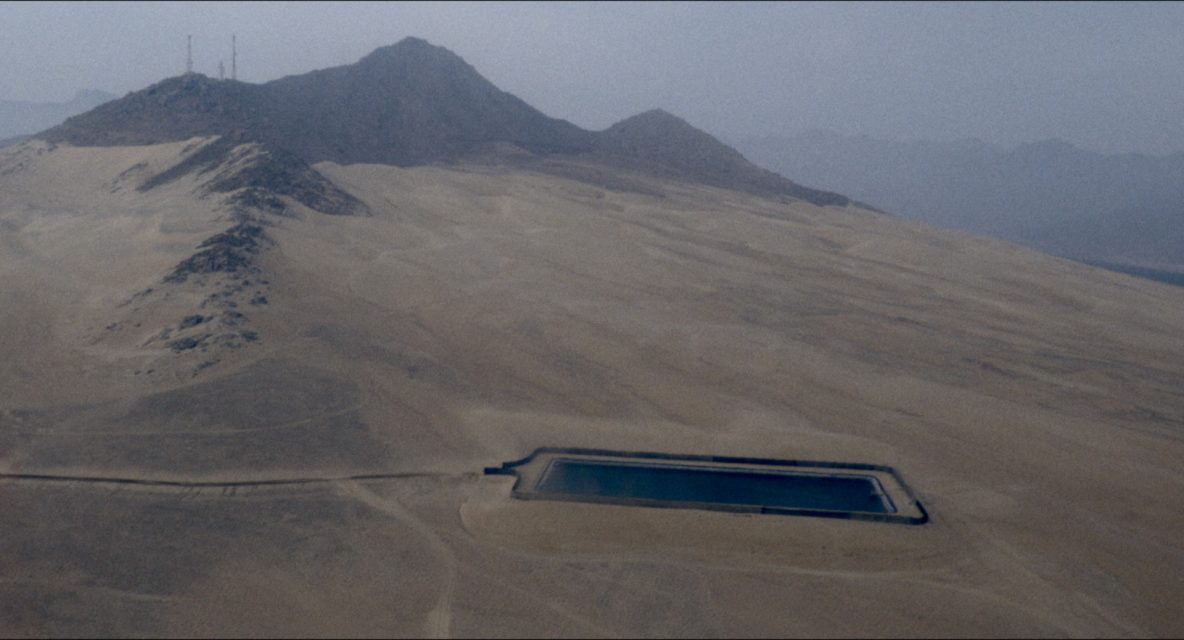
Aggregate States of Matters (2019).
For my latest film, Aggregate States of Matters (2019), I worked with Quechua communities in the Andes that are affected by glacier melting. The work is a further investigation into social transformations that are inscribed in the landscape. It highlights the ambiguous relation between humans and nature, and the constant negotiations in the creation of value deriving from nature.
While exploring different myths that were transformed into and carried by the landscape, I tried to depict the possibility of translating ancient knowledge into the present time. As in my previous films, Aggregate States of Matters features collective performances in which the memories of the protagonists interact with a scenario in the landscape. The film shows the blurring and melding boundaries between human and nonhuman actors. While some of the Indigenous population profits from the benefits and wealth of farming, which are rapidly increasing due to changing environmental conditions, they concurrently face fast-moving challenges in their spiritual and cultural lives. I walked with a group up to the Ausangate glacier to follow and film a ritual for the glacier. The extensive dialogues I had with the local people enter the film as a landscape of words that emerge on top of aerial footage I shot from a plane over the glaciers.
I tried to thematize the increasing awareness and evidence of human interference on Earth, which has led to a general perception of urgency, intangibility, and a state of permanent crisis, asking the central question of representation already posed by the scholar Rob Nixon: “How can we convert into image and narrative disasters that are slow moving and long in the making, disasters that are anonymous and that star nobody, disasters that are attritional and of indifferent interest to the sensation-driven technologies of our image-world? How can we turn the long emergencies of slow violence into stories dramatic enough to rouse public sentiment and warrant political intervention, these emergencies whose repercussions have given rise to some of the most critical challenges of our time?”
Rosa Barba: Double Whistler
